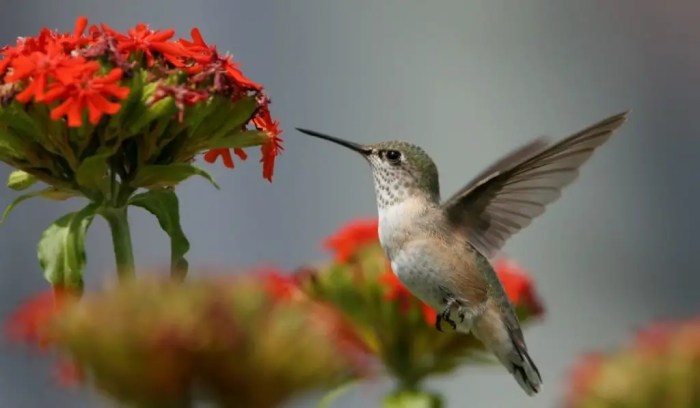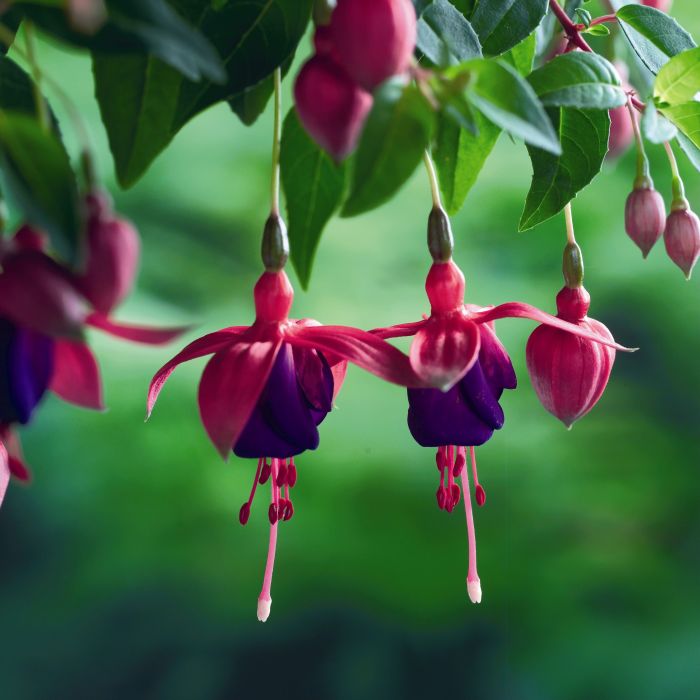As hanging plants for hummingbirds take center stage, this comprehensive guide beckons readers into a world crafted with unparalleled knowledge and journalistic flair, ensuring a reading experience that is both absorbing and distinctly original.
Discover the captivating allure of hanging plants for hummingbirds, exploring the specific characteristics that make these plants irresistible to these vibrant visitors. Learn how to choose and care for the perfect hanging plants, creating a safe and inviting environment that attracts and supports hummingbird populations.
Types of Hanging Plants for Hummingbirds
Hummingbirds are attracted to specific plant characteristics, including vibrant colors, tubular or bell-shaped flowers, and nectar production. Here’s a list of popular hanging plants that can entice these tiny, feathered visitors to your garden:
These plants provide a continuous source of nectar and attract hummingbirds throughout the year. Native species offer additional benefits, such as supporting local wildlife and promoting biodiversity.
Native Hanging Plants
- Coral Honeysuckle( Lonicera sempervirens): Produces clusters of bright red, trumpet-shaped flowers that bloom in spring and summer.
- Columbine( Aquilegia): Displays delicate, nodding flowers in shades of red, yellow, or blue. It blooms from spring to early summer.
- Wild Bleeding Heart( Dicentra eximia): Features heart-shaped pink flowers that bloom in spring. Its foliage provides a graceful accent to hanging baskets.
Non-Native Hanging Plants
- Fuchsia( Fuchsia): Boasts elegant, bell-shaped flowers in various colors, including pink, purple, and white. It blooms profusely from spring to fall.
- Petunia( Petunia): Produces an abundance of trumpet-shaped flowers in a wide range of colors. It blooms from spring to fall and is a favorite among hummingbirds.
- Calibrachoa( Calibrachoa): Also known as Million Bells, this plant displays masses of small, trumpet-shaped flowers in vibrant colors. It blooms profusely throughout the summer.
Benefits of Hanging Plants for Hummingbirds

Providing hanging plants for hummingbirds offers numerous advantages, creating a safe and inviting environment for these fascinating creatures. These plants play a crucial role in attracting and supporting hummingbird populations, fostering their well-being and contributing to the biodiversity of the ecosystem.
Attraction and Enticement
Hanging plants serve as visual cues for hummingbirds, enticing them with their vibrant colors and nectar-rich blooms. The flowers’ elongated, tubular shape perfectly accommodates the birds’ long, slender beaks, allowing them to easily extract the sweet liquid. By placing hanging plants in close proximity to feeders, hummingbirds can quickly locate a reliable food source.
Protection and Shelter
Hanging plants provide hummingbirds with much-needed protection and shelter from predators, inclement weather, and the sun’s intense rays. The dense foliage and hanging nature of these plants create a safe haven where the birds can rest, nest, and escape potential threats.
Hummingbirds are attracted to brightly colored, nectar-producing flowers. Hanging plants provide a great way to attract these birds to your garden. Some popular hanging plants for hummingbirds include fuchsia, honeysuckle, and lantana. Devils ivy bunnings hanging is another great option.
It is a fast-growing vine that produces long, trailing stems with variegated leaves. The flowers are small and white, but they are very attractive to hummingbirds. You can grow devils ivy bunnings hanging in a pot or basket, and it will quickly fill in and create a beautiful display.
Habitat Enhancement
Hanging plants enhance the overall habitat for hummingbirds by providing nesting sites and attracting insects that serve as a secondary food source. The dense foliage and sheltered environment created by these plants encourage hummingbirds to establish territories and raise their young in close proximity to a reliable food source.
Tips for Choosing and Caring for Hanging Plants

To attract hummingbirds to your garden, selecting and caring for the right hanging plants is crucial. Consider factors like plant size, flowering season, and sun exposure to ensure a thriving hummingbird-friendly environment.
Hanging plants are a great way to attract hummingbirds to your yard. They provide a place for the birds to perch and rest, and the flowers provide a source of nectar. Many different types of hanging plants are suitable for hummingbirds, including fuchsias, begonias, and impatiens.
Hanging plants can be a great way to add color and interest to your yard, while also providing a valuable resource for hummingbirds. To learn more about the benefits of hanging plants, you can read more here .
Choosing the Right Plants
- Size:Choose plants that are compact and can fit comfortably in hanging baskets.
- Flowering Season:Opt for plants that bloom during the hummingbird’s active season, typically spring to fall.
- Sun Exposure:Select plants that can tolerate the amount of sunlight your hanging location receives.
Caring for Hanging Plants, Hanging plants for hummingbirds
- Watering:Water regularly, especially during hot and dry weather, but avoid overwatering.
- Fertilizing:Fertilize every few weeks during the growing season with a balanced fertilizer.
- Pruning:Prune regularly to encourage new growth and flowering.
- Pest Control:Monitor for pests and treat as needed with organic or natural methods.
Designing a Hummingbird-Friendly Hanging Garden

To create a captivating hanging garden that attracts hummingbirds, meticulous planning and thoughtful execution are essential. Plant placement, color combinations, and the creation of a vertical oasis are crucial considerations in designing this avian sanctuary.
Plant Placement
Strategic placement of hanging plants is paramount to entice hummingbirds. Hang baskets at varying heights, allowing hummingbirds to easily access nectar from different angles. Position plants near windows or patios where hummingbirds are likely to frequent.
Color Combinations
Hummingbirds are drawn to bright colors, particularly red, orange, and pink. Choose plants with vibrant blooms to create a visual feast for these tiny birds. Consider mixing and matching colors to create a dynamic and visually appealing display.
Creating a Vertical Oasis
Hanging plants provide a vertical dimension to the garden, creating an illusion of space and a welcoming environment for hummingbirds. Utilize a variety of hanging baskets, pots, and trellises to create a layered effect that allows hummingbirds to explore different levels of the garden.
DIY Hanging Planter Ideas: Hanging Plants For Hummingbirds
Hummingbird enthusiasts can create unique and personalized hanging planters with a touch of creativity and resourcefulness. These DIY projects not only save costs but also allow for customization to complement the beauty of hanging plants and attract hummingbirds.
Upcycled Containers
Repurposing household items like tin cans, plastic bottles, or even old mugs can transform them into charming hanging planters. Clean and decorate these containers with paint, decoupage, or fabric scraps to match your style. Punch drainage holes and attach sturdy twine or wire for hanging.
Hanging plants for hummingbirds can add a touch of beauty to your garden while providing a food source for these fascinating birds. If you’re looking to purchase hanging plants for your hummingbird friends, you may be wondering how much they cost at Home Depot.
To find out more, you can check out how much are hanging plants at home depot . Hanging plants for hummingbirds come in a variety of sizes and styles, so you’re sure to find one that fits your needs and budget.
Macrame Magic
Macrame, the art of knotting cords, can be used to create intricate and stylish hanging planters. Using cotton, jute, or other natural fibers, follow simple knotting patterns to weave a sturdy net that supports your plants. Add beads or tassels for a touch of elegance.
Woodworking Wonders
For those with woodworking skills, crafting hanging planters from wood offers endless possibilities. Cut and assemble wooden planks into geometric shapes like cubes or hexagons. Sand and finish the wood for durability and aesthetics. Drill drainage holes and attach chains or hooks for hanging.
Recycled Newspaper Planters
An eco-friendly option is to make hanging planters from recycled newspapers. Roll up newspapers tightly into tubes and secure them with glue or twine. Arrange the tubes in a cylindrical or spherical shape and tie them together with yarn or string.
These planters are lightweight and provide excellent drainage.
Closure

Whether you’re a seasoned hummingbird enthusiast or just starting to explore the world of these fascinating creatures, this guide empowers you with the knowledge and inspiration to create a hummingbird-friendly oasis right outside your window. Embrace the joy of attracting these tiny, feathered gems and witness the transformative power of nature’s beauty.
FAQ Guide
What types of hanging plants are most attractive to hummingbirds?
Fuchsias, impatiens, begonias, and lantanas are among the most popular hanging plants that attract hummingbirds with their vibrant blooms and nectar-rich flowers.
How do I care for hanging plants for hummingbirds?
Ensure proper drainage, water regularly, and fertilize monthly during the growing season. Choose plants that thrive in the sun or partial shade, depending on your climate.
Can I make my own hanging planters for hummingbirds?
Yes, you can create unique and personalized hanging planters using materials like recycled containers, wire baskets, or macrame. Experiment with different designs to enhance the beauty of your hanging plants and appeal to hummingbirds.